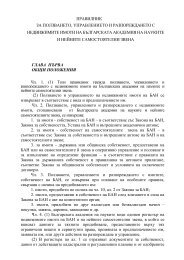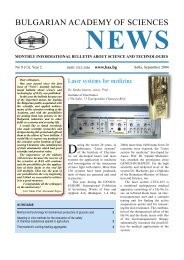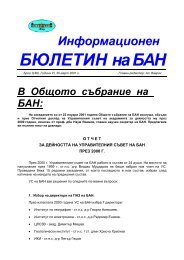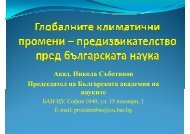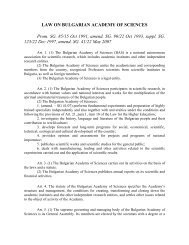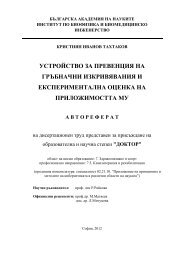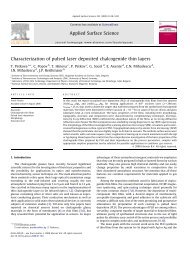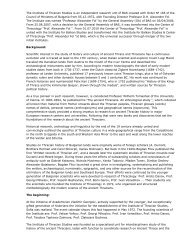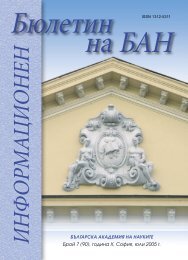View - ResearchGate
View - ResearchGate
View - ResearchGate
- No tags were found...
Create successful ePaper yourself
Turn your PDF publications into a flip-book with our unique Google optimized e-Paper software.
Sensors and Actuators B 143 (2009) 395–399Contents lists available at ScienceDirectSensors and Actuators B: Chemicaljournal homepage: www.elsevier.com/locate/snbComplex (As 2 S 3 ) (100−x) (AgI) x chalcogenide glasses for gas sensorsKolyo Kolev a , Cyril Popov b , Tamara Petkova a,∗ , Plamen Petkov c ,Ion N. Mihailescu d , Johann Peter Reithmaier ba Institute of Electrochemistry and Energy Systems (IEES), Bulgarian Academy of Sciences, 1113 Sofia, Bulgariab Institute of Nanostructure Technologies and Analytics (INA), University of Kassel, Germanyc Laboratory of Thin Film Technology, Department of Physics, University of Chemical Technology and Metallurgy, 1756 Sofia, Bulgariad Laser-Surface-Plasma Interactions Laboratory, Lasers Department, National Institute for Lasers, Plasma and Radiations Physics, PO Box MG-54, Magurele RO-77125, RomaniaarticleinfoabstractArticle history:Received 7 July 2009Received in revised form 11 August 2009Accepted 12 August 2009Available online 20 August 2009Keywords:Chalcogenide glassesThin filmsSorption propertiesGas sensorsThe sorption properties of thin amorphous As–S–AgI layers were investigated using resonating cantilevers.The coatings were deposited on the cantilevers by vacuum thermal evaporation from thecorresponding bulk glasses, followed by exposure to analytes (water, volatile organic compounds, ammonia)with different concentrations. The highest sensitivity was observed towards acetone, the analytewith one of the highest molecular weights and with the lowest dipole moment among the tested analytes.The sensor acted primarily as a microbalance distinguishing the vapors by the difference in theirmolecular weight. However, the peculiarities in the interaction sensing coating–analyte molecules arereflected in the sensitivity towards molecules with different polarities. The short response and recoverytimes together with the linear increase of the response signals with the analyte concentration make theinvestigated As–S–Ag films a promising candidate for gas sensitive elements.© 2009 Elsevier B.V. All rights reserved.1. IntroductionThe development of gas sensor devices with optimized selectivityand sensitivity has been gaining prominence in the recent years,addressing as one of the most critical point the application of novelsensing materials for high-performance sensors. The semiconductorgas sensors are rather promising because they are compact, oflow-cost, and possess high sensitivity and low power consumption.Several oxide semiconductors have been intensively investigated,however, the sensors based on these materials exhibit some weakpoints, for example, the low selectivity and slow response of SnO 2 -based sensors [1,2]. On the other hand, WO 3 gas sensors with Pd, Ptor Au as an activator demonstrate a higher sensitivity, and a MoO 3 -based NO 2 sensor shows shorter response time, but they all requireelevated operation temperatures [3,4].The possibility for preparation of chalcogenide-based gas sensorswhich work at room temperatures, in contrast to the oxidesensors, is a great advantage and gives additional motivation forthe investigation of new crystalline and glassy chalcogenide materials[5,6]. The chalcogenide glassy semiconductors differ from theircrystalline counterparts by a much more flexible structure and byenormous variations of their properties, due to their disorderednature and almost unlimited ability for doping and alloying. That is∗ Corresponding author. Tel.: +359 2 724339; fax: +359 2 722544.E-mail address: tpetkova@bas.bg (T. Petkova).why it is assumed that vitreous compositions on the basis of chalcogenideglasses in the form of membranes [7,8] or thin films [9–17]may function as chemical sensitive inorganic materials.In the current work we have investigated the sorption propertiesof (As 2 S 3 ) 100−x (AgI) x coatings functionalized on sensor cantileversupon their exposure to vapors of water, ammonia and volatileorganic compounds (VOC) to evaluate their possible application ingas sensors.2. ExperimentalThe bulk (As 2 S 3 ) (100−x) (AgI) x (x = 10, 20 mol%) samples wereprepared by standard melt-quenching technique from As 2 S 3 , previouslysynthesized by us, and commercial AgI (Alfa Aesar, JohnsonMatthey). The initial substances with total weight of 5 g were sealedin evacuated quartz ampoules (10 −3 Pa). They were slowly heatedin a furnace with a rate of 2 K/min up to 873 K with temperaturemaintenance for 2 h and continuous vibrational stirring at the meltingpoints of the As 2 S 3 and AgI, and then quenched rapidly in amixture of water and ice.Thin films were deposited from the corresponding bulk glassesby thermal vacuum evaporation in a standard high-vacuum set-up(Hochvakuum B 30.2). The process conditions were as follow: residualpressure in the chamber of 1.33 × 10 −3 Pa, a distance betweenthe evaporation source and the substrates of 0.12 m, and evaporationtemperatures ranging between 1200 and 1300 K, dependingon the glass composition. An inductively heated and covered rib-0925-4005/$ – see front matter © 2009 Elsevier B.V. All rights reserved.doi:10.1016/j.snb.2009.08.016
396 K. Kolev et al. / Sensors and Actuators B 143 (2009) 395–399Fig. 1. SEM micrographs of the resonating cantilever coated with (As 2S 3) 90(AgI) 10film.bon evaporator from tantalum was used. The substrates wererotated during the deposition which allows the preparation ofhomogeneous and uniform in thickness films. The evaporation timewas determined by the desired thickness of the films. The latterwas controlled by cross-section scanning electron microscopy(SEM, Hitachi S-4000). Atomic force microscopy (AFM, NanoscopeDimension 3100) provided information about the topography of thedeposited As–S–Ag films.The fabrication process of the sensor cantilevers is a modificationof the double-sided silicon micromachining process, developedfor manufacturing of piezoresistive AFM sensors [18,19]. The mainidea of this complementary metal-oxide-semiconductor (CMOS)technology is the integration of the transducer, actuator and readoutunit on the same chip. This sensor represents a miniatureversion of a microbalance [20] based on the mechanical principlethat the resonance frequency of a microcantilever, moved bya piezoelectric actuator, decreases when mass is added to it. Theresulting vibrations are registered by piezoresistors connected in aWheatstone bridge, integrated at the base of the rectangular microbeam. The miniature dimensions of the microbeam (width 120 m,length 150 m, thickness 12 m) make its oscillations extremelysensitive towards the change of mass due to adsorbed gases (themeasured sensitivity of deflection is 1 mV/nm) [21]. For the investigationof the sorption properties of the chalcogenide materials onlythe cantilever micro beam was coated with 1.8 m (As 2 S 3 ) 90 (AgI) 10film (Fig. 1).The set-up used for the study of the sorption properties ofthe chalcogenide materials is described in details previously [22].In brief, it possesses two main parts—a measurement chamber(48 cm 3 ) with a gas handling system controlled by mass flowcontrollers and an electrical measurement circuit. The sorptionproperties of the As–S–AgI films were investigated upon exposureto water, methanol, ethanol, isopropanol, acetone and ammoniavapors, transported from evaporators to the measurement cell withdry nitrogen with a total flow rate of 150 ml/min.Fig. 2. Cross-section SEM micrography of the (As 2S 3) 90(AgI) 10 film.Afterwards a microcantilever sensor functionalized with a(As 2 S 3 ) 90 (AgI) 10 coating was exposed in the measurement chamberto vapors of different analytes with different concentrations in thegas flow and the dynamic responses (resonance frequency) weremeasured. The change in the cantilever resonance frequency providesa direct measure of the amount of adsorbed vapor at constantambient temperature in the chamber. The mass of the adsorbedvapors m can be estimated by [23,24]:m =K40.24( 1 2 − 1 2 1 2)where 1 and 2 are the resonance frequencies before and afterexposure to the analyte, respectively. The spring constant K isK = Ebd34l 3 (2)where E is the Young’s modulus of bulk silicon (E = 169 GPa), b,d and l the width, thickness and length of the cantilever beam,respectively. In general, the shift of the resonance frequency f isa combination of the effects of both [24] mass loading m, and thevariation in the spring constant K. However, negligible changesin the spring constant K can be assumed which leads to a directdependence of the resonance frequency shift on the mass of theadsorbed analyte.(1)3. Results and discussionThe thickness, morphology and topography of the As–S–AgIfilms were examined before investigating their sorption properties.SEM observations showed that they were smooth and uniformin thickness (Fig. 2). The rms roughness of the layers determined byAFM over 5 m × 5 m areas was on the order of 2–3 nm (Fig. 3).Fig. 3. AFM image of 5 m × 5 m surface of the (As 2S 3) 90(AgI) 10 film (z-scale3 nm/div).
K. Kolev et al. / Sensors and Actuators B 143 (2009) 395–399 397Table 1Molecular weights and electric dipole moments of analyte molecules in gas phase [25].AnalyteWaterH 2OMethanolCH 3OHEthanolC 2H 5OHIsopropanol(CH 3) 2CHOHAcetoneCH 3COCH 3AmmoniaNH 3Molecular weight [g/mol] 18.01 32.04 46.07 60.11 58.08 17.03Dipole moment [D] 1.85 1.70 1.69 1.66 1.30 1.47Fig. 4. Time responses of the cantilever upon exposure to water, methanol, isopropanoland acetone vapors.Fig. 4 shows the changes in the dynamic responses for 4 volatileanalytes (water, methanol, isopropanol and acetone) with concentrationsbetween 8 and 54 vol% in the measurement cell. Thefrequency shift is due to the sorption of the analyte moleculesonto/into the sensitive film resulting in an increase of the cantilevermass and a corresponding decrease of its resonance frequency, asdiscussed above. In principle both, surface adsorption and in-depthabsorption, can contribute substantially to the sensitivity towardsanalyte molecules. However, having in mind the dense structureof the amorphous (As 2 S 3 ) 90 (AgI) 10 films (density of the correspondingbulk sample 3.31 ± 0.1 g/cm 3 ) we can assume that thecontribution of the in-depth absorption is negligible. The responsestowards all tested analytes are relatively weak also suggestingphysisorption of the gas molecules on the surface of the sensitivelayer. The responses are reversible, as seen from the figure, andthe initial baseline is recovered again after the desorption of theanalyte molecules from the film during the nitrogen purging step.The signal magnitude increases with the analyte concentration, i.e.the number of physisorbed molecules is higher by higher analyteconcentration in the gas phase; thus the largest responses weredetected for 54 vol% analytes.The sensor shows a good linearity over a wide range of concentrationsfor all tested analytes (Fig. 5). The sensitivity and selectivityproperties of the sensor will depend on the surface state of thesensitive layer as well as on its ability to adsorb different gases.However, at equal gas adsorption ability, the sensor based on themechanical principle of a microbalance, is expected to distinguishbetween gases and vapors by the difference in their molecularweights. As seen in Fig. 5, the sensor exhibits the largest sensitivitytowards acetone, i.e. towards the analyte with one of the highestmolecular weights (Table 1), and it decreases with the decrease ofthe molecular weight of the analytes. The polarity of the analytemolecules seems to play also a role in the sorption mechanism. Aprobable repulsion of the polar molecules from the chalcogenidesurface favors the physisorption of molecules with relatively lowdipole moment (see Table 1). This could explain the higher sensi-Fig. 5. Resonance frequency shift towards the concentration of various analytes.Fig. 6. Variations in resonance frequency with time (a) after introduction of 54 vol%acetone vapor and (b) after replacement by dry nitrogen.
398 K. Kolev et al. / Sensors and Actuators B 143 (2009) 395–399tivity towards acetone (M = 58.08 g/mol, = 1.30 D) in comparisonwith the rest analytes, and especially with isopropanol which possessesclose molecular weight but higher polarity (M = 60.11 g/mol, = 1.66 D). In a similar way, ammonia (M = 17.03 g/mol, = 1.47 D)is sensed much better than water (M = 18.01 g/mol, = 1.85 D).The variation of the resonance frequency upon exposure of thecantilever sensor to acetone vapors (54 vol%) as a function of timeis shown in Fig. 6. The response and recovery times are on the orderof 25 s and 15 s, respectively; similar times were observed also forthe other tested analytes. The leading slope of the analyte injectionand the longer response time should be explained by the saturationtime of the chamber volume rather than by the response time ofthe sensor itself. The stability of the responses was confirmed byseveral measuring cycles over a test period of few months.4. ConclusionsResonating cantilevers functionalized with amorphous(As 2 S 3 ) 90 (AgI) 10 film were exposed to vapors of different analytes,including water, VOC and ammonia, in order to study the sorptionproperties of the chalcogenide coating. The highest sensitivity wasobserved towards acetone, the analyte with one of the highestmolecular weights and with the lowest dipole moment amongthe tested analytes. The sensor acted primarily as a microbalancedistinguishing the vapors by the difference in their molecularweight. However, the peculiarities in the interaction sensingcoating–analyte molecules are reflected in the sensitivity towardsmolecules with different polarities. The short response and recoverytimes together with the linear increase of the response signalswith the analyte concentration make the investigated As–S–Agfilms a promising candidate for gas sensitive elements.AcknowledgementsThe authors gratefully acknowledge the financial support ofNATO under the Collaborative Linkage Grant Program (CBP.EAP.CLG982793). The study is implemented thanks to financial assistanceunder the contract WUF-05 with the National Science Found, BulgarianMinistry of Education. The authors would like to thank Dr.D. Filenko and Prof. I.W. Rangelow for providing of the sensor cantileversand fruitful discussions during the course of the work.References[1] W. Göpel, K.-D. Schierbaum, SnO 2 sensors: current status and future prospects,Sens. Actuators B 26/27 (1995) 1–12.[2] H. Meixner, J. Gerblinger, U. Lampe, M. Fleischer, Thin-film gas sensors basedon semiconducting metal oxides, Sens. Actuators B 23 (1995) 119–125.[3] M. Penza, C. Martucci, G. Cassano, NO x gas sensing characteristics of WO 3 thinfilms activated by noble metals (Pd, Pt, Au) layers, Sens. Actuators B 50 (1998)52–59.[4] M. Ferroni, V. Guidi, G. Martinelli, M. Sacerdoti, P. Nelli, G. Sberveglieri, MoO 3-based sputtered thin films for fast NO 2 detection, Sens. Actuators B 48 (1998)285–288.[5] D. Tsiulyanu, S. Marian, H.–D. Liess, I. Eisele, Effect of annealing and temperatureon the NO 2 sensing properties of tellurium based films, Sens. Actuators B 100(2004) 380–386.[6] A.A. Sagade, R. Sharma, Copper sulphide (Cu xS) as an ammonia gas sensorworking at room temperature, Sens. Actuators B 133 (2008) 135–143.[7] R. Tomova, R. Stoycheva-Topalova, A. Buroff, Ion-selective membranes basedon chalcogenide glasses, J. Optoelectronics Adv. Mater. 7 (2005) 1399–1406.[8] V.S. Vassilev, S.V. Boycheva, Chemical sensors with chalcogenide glassy membranes,Talanta 67 (2005) 20–27.[9] M.J. Schöning, C. Schmidt, J. Schubert, W. Zander, S. Mesters, P. Kordos, H. Lüth,A.V. Legin, B. Seleznev, Yu. Vlasov, Thin film sensors on the basis of chalcogenideglass materials prepared by pulsed laser deposition technique, Sens. ActuatorsB 68 (2000) 254–259.[10] Yu.G. Mourzina, M.J. Schöning, J. Schubert, W. Zander, A.V. Legin, Yu.G. Vlasov, P.Kordos, H. Lüth, A new thin-film Pb microsensor based on chalcogenide glasses,Sens. Actuators B 71 (2000) 13–18.[11] Yu.G. Mourzina, T. Yoshinobu, J. Schubert, H. Lüth, H. Iwasaki, M.J. Schöning,Ion-selective light-addressable potentiometric sensor (LAPS) with chalcogenidethin film prepared by pulsed laser deposition, Sens. Actuators B 80(2001) 136–140.[12] J. Schubert, M.J. Schöning, Yu.G. Mourzina, A.V. Legin, Yu.G. Vlasov, W. Zander,H. Lüth, Multicomponent thin films for electrochemical sensor applicationsprepared by pulsed laser deposition, Sens. Actuators B 76 (2001) 327–330.[13] S. Marian, D. Tsiulyanu, H.-D. Liess, Ge–Te–As-based gas sensor selective to lowNO 2 concentrations, Sens. Actuators B 78 (2001) 191–194.[14] S. Marian, D. Tsiulyanu, T. Marian, H.-D. Liess, Chalcogenide-based chemicalsensors for atmospheric pollution control, Pure Appl. Chem. 73 (2001)2001–2004.[15] J.P. Kloock, Yu.G. Mourzina, J. Schubert, M.J. Schöning, A first step towards amicrofabricated thin film sensor array on the basis of chalcogenide glass material,Sensors 2 (2002) 356–365.[16] J.P. Kloock, Yu.G. Mourzina, Y. Ermolenko, T. Doll, J. Schubert, M.J. Schöning,Inorganic thin-film sensor membranes with PLD-prepared chalcogenideglasses: challenges and implementation, Sensors 4 (2004) 156–162.[17] R. Desai, D. Lakshminarayana, P.B. Patel, C.J. Panchal, Indium sesquitelluride(In 2Se 3) thin film gas sensor for detection of carbon dioxide, Sens. Actuators B107 (2005) 523–527.[18] I.W. Rangelow, T. Gotszalk, P. Hudek, F. Shi, P.B. Grabiec, P. Dumania, Fabricationof piezoresistive-sensed AFM cantilever probe with integrated tip, Proc. SPIE2879 (1996) 56–64.[19] R. Linnemann, T. Gotszalk, I.W. Rangelow, P. Dumania, E. Oesterschulze, Atomicforce microscopy and lateral force microscopy using piezoresistive cantilevers,J. Vac. Sci. Technol. B 14 (1996) 856–860.[20] H. Baltes, D. Lange, A. Koll, The electronic nose in Lilliput, IEEE Spectrum Sept.35 (1998) 35–38.[21] T. Gotszalk, P. Grabiec, I. Rangelow, Piezoresistive sensors for scanning probemicroscopy, Ultramicroscopy 82 (2000) 39–48.[22] B. Monchev, D. Filenko, N. Nikolov, C. Popov, T. Ivanov, P. Petkov, I.W. Rangelow,Investigation of the sorption properties of thin Ge–S–AgI films deposited oncantilever-based gas sensor, Appl. Phys. A 87 (2007) 31–36.[23] T. Thundat, R. Warmack, G. Chen, D. Allison, Thermal and ambient-induceddeflections of scanning force microscope cantilevers, Appl. Phys. Lett. 64 (1994)2894–2896.[24] G. Chen, T. Thundat, E. Wachter, J. Warmack, Adsoprtion-induced surface stressand its effects on resonance frequency of microcantilevers, J. Appl. Phys. 77(1995) 3618–3622.[25] R.C. Weast (Ed.), Handbook of Chemistry and Physics, 54th ed., CRC Press,Cleveland, USA, 1974.BiographiesKolyo Kolev received his master degree from the University of Chemical Technologyand Metallurgy, Sofia, Bulgaria, in 2004. Currently he is a PhD student at the Instituteof Electrochemistry and Energy Systems (IEES), Bulgarian Academy of Sciences,Bulgaria. His research includes synthesis and characterization of amorphous bulkmaterials and thin films, complicated ion-conductive glasses, optical and electricalproperties of amorphous materials.Cyril Popov has received his MSc in Chemical Engineering in 1990 and PhD in 1994from the University of Chemical Technology and Metallurgy, Sofia, Bulgaria. AfterPostdoc stays at the National Institute of Advanced Industrial Science and Technology,Tsukuba, Japan, and at the Central Laboratory of Photoprocesses, BulgarianAcademy of Sciences, Sofia, since 1998 he works at the Institute of NanostructureTechnologies and Analytics (INA), University of Kassel, Germany, where at thepresent he is a group leader. His research interests cover thin film technology andcharacterization, including investigation of application relevant properties.Tamara Petkova completed MSc in 1981 at the University of Chemical Technologyand Metallurgy, Sofia, and PhD in Physical Chemistry in 1992 at the Central Laboratoryof Optical Storage and Processing of Information of the Bulgarian Academyof Sciences. Her doctoral thesis involved the investigation of new chalcogenidematerials as optical storage media. She became Research Associate at the Instituteof Electrochemistry and Energy Systems (IEES-BAS) in 1995. After a postdoctoralappointment at the University of Patra, Greece, in the field of Solid State Physics, shehas been promoted and currently is Head of the Solid State Electrolytes Departmentat IEES. Her research interests include characterization of amorphous materials.Plamen Petkov has received his degree in Physics from the University of ChemicalTechnology and Metallurgy, Sofia, in 1981 and PhD in Physics in 1994. He hasworked as a Postdoc at I. Physicalisches Institut, RWTH, Aachen, Germany, Universityof Odense, Denmark, and University of Bonn, Germany. He is a full professor ofApplied Physics at the University of Chemical Technology and Metallurgy, Sofia, andhead of Thin Film Technology Laboratory. His research activity is mainly devoted tothe investigation of electrical and optical properties of semiconductor materials foradvanced technological applications.Ion N. Mihailescu is Head of Laser-Surface-Plasma Interactions Laboratory at theNational Institute for Lasers, Plasma, and Radiation Physics (INFLPR), Bucharest,Romania, since 1975. In 1990 he became Professor at the Faculty of Physics, Universityof Bucharest. His research interests encompass laser and plasma physics,nanostructured thin films technology, biomaterials and tissue engineering, modi-
K. Kolev et al. / Sensors and Actuators B 143 (2009) 395–399 399fication and characterization of nanostructured thin coatings, optoelectronics, gasand bio-sensors.Johann Peter Reithmaier studied Physics at TU Munich and made his PhD atSiemens and Walter-Schottky-Institute in 1990. Until 1992, he worked as Postdocat IBM in Rüschlikon, Switzerland, on III/V epitaxy. In 1992, he joined the Universityof Würzburg where he built up a research group working on nanostructured semiconductorsand their applications in optoelectronic devices. In 2005 he became afull professor of Physics and director of the Institute of Nanostructure Technologiesand Analytics at the University of Kassel. He is author or co-author of more than 430journal and conference papers (220 in refereed journals and 65 invited talks). He isa member of the Deutsche Physikalische Gesellschaft (DPG) and of IEEE PhotonicsSociety (senior member).



